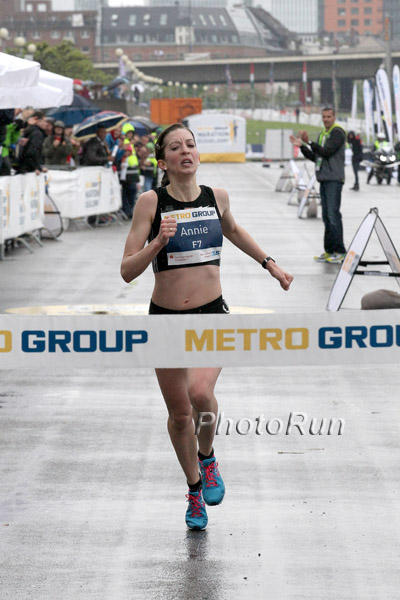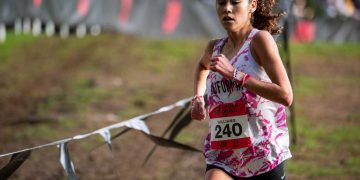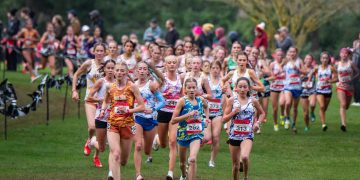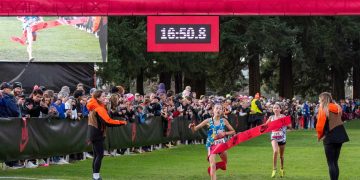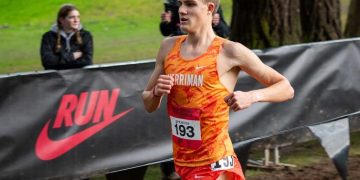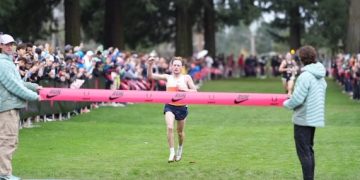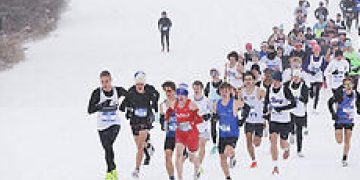RelatedPosts
Young Runners and the Issues of Volume and Intensity
Typically the first thing everyone asks when a new ‘phenom’ busts onto the scene is, “How much are they doing?” This single question, often with the accompanying quizzical eyebrow raise, encompasses a lot: mileage, intensity of workouts, how many workouts, cross-training, and who’s driving the training-the athlete?
The reason elders in the sport tend to ask with a bit of hesitation is based primarily off of experience. A flag goes up when you see an eight-year-old beating high-schoolers, and that flag turns to red if you hear the runner is putting in more mileage AND hard workouts than said high-schoolers.
The volumes and kinds of workouts for young runners need to be different pre-high school, freshman to senior, and then transitioning into college. This sounds like mere logic, but it’s sometimes lost amidst the drive for immediate returns. Unfortunately, impatience tends to bite runners in the backside and a failure to look long-term, especially with younger harriers, is even more disastrous.
Coach Dena Evans
Young Runners and the Issues of Volume and Intensity
Typically the first thing everyone asks when a new ‘phenom’ busts onto the scene is, “How much are they doing?” This single question, often with the accompanying quizzical eyebrow raise, encompasses a lot: mileage, intensity of workouts, how many workouts, cross-training, and who’s driving the training-the athlete?
The reason elders in the sport tend to ask with a bit of hesitation is based primarily off of experience. A flag goes up when you see an eight-year-old beating high-schoolers, and that flag turns to red if you hear the runner is putting in more mileage AND hard workouts than said high-schoolers.
The volumes and kinds of workouts for young runners need to be different pre-high school, freshman to senior, and then transitioning into college. This sounds like mere logic, but it’s sometimes lost amidst the drive for immediate returns. Unfortunately, impatience tends to bite runners in the backside and a failure to look long-term, especially with younger harriers, is even more disastrous.
Coach Dena Evans(http://www.runcoach.com/), previously coaching the Stanford’s women team, isn’t against children getting started in running at an ‘early’ age, she herself did. She pointing out there are a myriad of benefits for getting youths involved in athletics: positive bone health, fighting obesity, self-esteem boosting, and a fun, social environment. The line that tends to get crossed is when the fun gets stripped away and the focus turns solely to times and performances.
“Whatever you do, it should be a gradual progression that includes a lot of stuff that is conversational and social-based,” states Evans. “If you have the occasional race to work on the competitive piece that’s probably positive, but I don’t think forcing that every day at practice is necessarily always positive at the age when we’re trying to introduce kids to a lifelong enjoyment of the sport.” She also recommends that the younger the runner, the more involved with other sports they should be, rather than selectively just running.
This is hardly to say there isn’t going to come a time for hard workouts and tough races, but more along the lines of letting the athlete be the guide. “I think that kids that are running sort of self-identify a little bit on [intensity],” explains Evans, “kids have a willingness to take the next step.” She points out it isn’t until college that some runners hit that self-identification or see their running develop into a level of National caliber. The point is: there is time.
Broomfield high school coach, Greg Weich, previously coached at Smokey Hill High and is no stranger to ushering along burgeoning talent, National Champions among them. When a freshman enters his program he has a 13-point list of things he assesses before writing up any training. “Years of past running. How does the athlete respond emotionally during hard training? Physical development, NOT AGE,” among them. What he cites as most important is: “Previous loads handled WITHOUT INJURY…All of these will factor in when training young athletes, particularly young female athletes.”
Coach Jay Johnson’s(http:// CoachJayJohnson.com/) approach centers around the training age of a runner, “I think the key is to look at training age versus chronological age.” That’s years spent running year-round, or at least the majority of a year with other sports between. “Every athlete is different that’s why I want to look at their training age and go from there.” The younger the runner, “I think that structured training should be approached with caution.” By the time a runner hits high school and is looking to progress, workouts and training need to be attacked with a long-term approach, “Patience with training and the process. Impatient runners won’t have long careers.” The runners who are able to keep improving to senior year, into college, and beyond, “They must love the sport. [And] intrinsically motivated to train.”
Addressing female athletes in particular, Evans brings up the female triad and saying, “Any coach or parent needs to be mindful of how those changes are going.” Girls all develop at different ages, sometimes it isn’t until hitting college that their bodies start to change. This needs to be handled with care, not just emotionally, but physically as well, to avoid injuries. “There’s not necessarily going to be a linear path for girls, the same where there might be for boys.”
Take each runner as a study of one; individuality and gradual progression are the rules that win out in this sport. Along with that, patience. Balancing volume and intensity is something even the professionals, with years and years to their training age, are still manipulating and tweaking. The point is, the younger the runner, the more years that they can potentially be training and thus improving. That will only change if the harrier is overloaded too early and winds up injured or leaving the sport entirely.
———————–
Caitlin Chock (caitchock.com) set the then National High School 5k Record (15:52.88) in 2004. Now a freelance writer and artist she writes about all things running and designs her own line of running shirts. You can read more, see her running comics, and her shirts at her website.), previously coaching the Stanford’s women team, isn’t against children getting started in running at an ‘early’ age, she herself did. She pointing out there are a myriad of benefits for getting youths involved in athletics: positive bone health, fighting obesity, self-esteem boosting, and a fun, social environment. The line that tends to get crossed is when the fun gets stripped away and the focus turns solely to times and performances.
“Whatever you do, it should be a gradual progression that includes a lot of stuff that is conversational and social-based,” states Evans. “If you have the occasional race to work on the competitive piece that’s probably positive, but I don’t think forcing that every day at practice is necessarily always positive at the age when we’re trying to introduce kids to a lifelong enjoyment of the sport.” She also recommends that the younger the runner, the more involved with other sports they should be, rather than selectively just running.
This is hardly to say there isn’t going to come a time for hard workouts and tough races, but more along the lines of letting the athlete be the guide. “I think that kids that are running sort of self-identify a little bit on [intensity],” explains Evans, “kids have a willingness to take the next step.” She points out it isn’t until college that some runners hit that self-identification or see their running develop into a level of National caliber. The point is: there is time.
Broomfield high school coach, Greg Weich, previously coached at Smokey Hill High and is no stranger to ushering along burgeoning talent, National Champions among them. When a freshman enters his program he has a 13-point list of things he assesses before writing up any training. “Years of past running. How does the athlete respond emotionally during hard training? Physical development, NOT AGE,” among them. What he cites as most important is: “Previous loads handled WITHOUT INJURY…All of these will factor in when training young athletes, particularly young female athletes.”
Coach Jay Johnson’s(http:// CoachJayJohnson.com/) approach centers around the training age of a runner, “I think the key is to look at training age versus chronological age.” That’s years spent running year-round, or at least the majority of a year with other sports between. “Every athlete is different that’s why I want to look at their training age and go from there.” The younger the runner, “I think that structured training should be approached with caution.” By the time a runner hits high school and is looking to progress, workouts and training need to be attacked with a long-term approach, “Patience with training and the process. Impatient runners won’t have long careers.” The runners who are able to keep improving to senior year, into college, and beyond, “They must love the sport. [And] intrinsically motivated to train.”
Addressing female athletes in particular, Evans brings up the female triad and saying, “Any coach or parent needs to be mindful of how those changes are going.” Girls all develop at different ages, sometimes it isn’t until hitting college that their bodies start to change. This needs to be handled with care, not just emotionally, but physically as well, to avoid injuries. “There’s not necessarily going to be a linear path for girls, the same where there might be for boys.”
Take each runner as a study of one; individuality and gradual progression are the rules that win out in this sport. Along with that, patience. Balancing volume and intensity is something even the professionals, with years and years to their training age, are still manipulating and tweaking. The point is, the younger the runner, the more years that they can potentially be training and thus improving. That will only change if the harrier is overloaded too early and winds up injured or leaving the sport entirely.
———————–
Caitlin Chock (caitchock.com) set the then National High School 5k Record (15:52.88) in 2004. Now a freelance writer and artist she writes about all things running and designs her own line of running shirts. You can read more, see her running comics, and her shirts at her website.
Author
-

Larry Eder has had a 52-year involvement in the sport of athletics. Larry has experienced the sport as an athlete, coach, magazine publisher, and now, journalist and blogger. His first article, on Don Bowden, America's first sub-4 minute miler, was published in RW in 1983. Larry has published several magazines on athletics, from American Athletics to the U.S. version of Spikes magazine. He currently manages the content and marketing development of the RunningNetwork, The Shoe Addicts, and RunBlogRun. Of RunBlogRun, his daily pilgrimage with the sport, Larry says: "I have to admit, I love traveling to far away meets, writing about the sport I love, and the athletes I respect, for my readers at runblogrun.com, the most of anything I have ever done, except, maybe running itself." Also does some updates for BBC Sports at key events, which he truly enjoys.
Theme song: Greg Allman, " I'm no Angel."
View all posts


